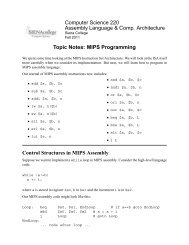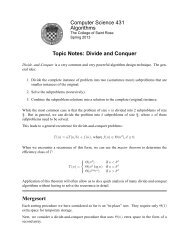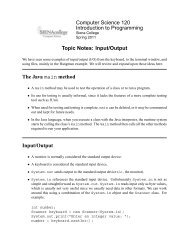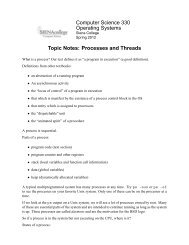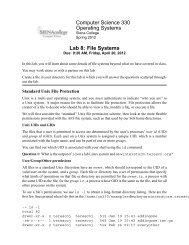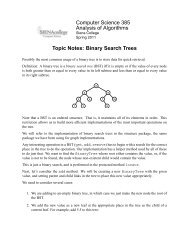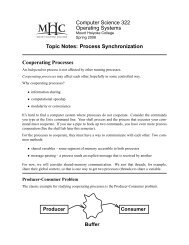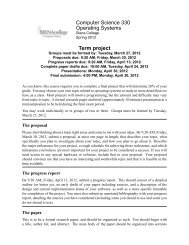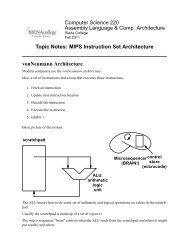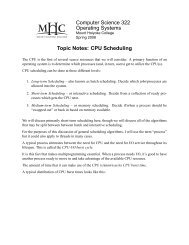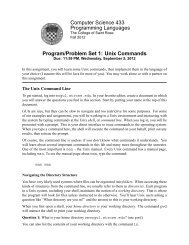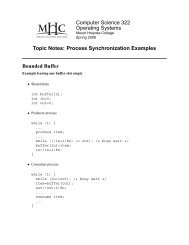Topic Notes: Sorting - Courses
Topic Notes: Sorting - Courses
Topic Notes: Sorting - Courses
You also want an ePaper? Increase the reach of your titles
YUMPU automatically turns print PDFs into web optimized ePapers that Google loves.
CS 211 Data Structures Fall 2009We will build sorting procedures out of two main operations:• compare two elements• swap two elementsWe know how to compare base types, and we saw the idea of Comparables for comparingobjects that provide a compareTo() method.A swap is very easy to write in Java. If we have an array of some base type, we can write:public static void swap(int data[], int i, int j) {}int temp = data[i];data[i] = data[j];data[j] = temp;If we have an array of Object references, we can easily just change the types of the array and thetemp variable.public static void swap(Object data[], int i, int j) {}Object temp = data[i];data[i] = data[j];data[j] = temp;Or, using generics:public static void swap(T[] data, int a, int b) {}T temp = data[a];data[a] = data[b];data[b] = temp;In this case, there is no great benefit to the generic version. We don’t really care what the typesof the elements of the array actually are. We are not treating them as anything more specific thanObjects.However, if you need to write a swap method inside a generic class, you will need to use thegeneric type.4
CS 211 Data Structures Fall 2009work for current input.A Simple Correctness Proof: FastPowerConsider this method:// pre: exp >= 0// post - Returns base raised to exppublic static int fastPower(int base, int exp) {if (exp == 0)return 1;if (exp%2 == 1) // exp is oddreturn base * fastPower(base, exp-1);return fastPower(base * base, exp / 2);}We wish to show that the method is correct, that fastPower(base,exp) = base exp .Proof: We will proceed by mathematical induction on the value of exp.Base case: exp = 0, fastPower(base,0) = 1 = base 0 – correctInductive hypothesis: Assume that fastPower(base,exp) = base exp for all exp < n.Inductive step: Show that fastPower(base,n) = base nThere are two cases to consider:• n is odd: fastPower(base,n) = base * fastPower(base, n-1) = base ∗base n−1 (by induction) = base n• n is even: fastPower(base,n) = fastPower(base*base,n / 2) = (base 2 )(n/2)(by induction) = base n (since n is even)Therefore by mathematical induction, the method works correctly for all values of exp 0).8
CS 211 Data Structures Fall 2009The for loop finds largest element in the unsorted part of the array and then swaps it withelts[lastIndex].Thus, at the end of the loop, elts[lastIndex] holds the largest element of the array.Since lastIndex - 1 < lastIndex, we know (by the inductive hypothesis) that rec-SelSort(lastIndex-1,elts) sorts elts[0..lastIndex-1] correctly.So at the end of the method, elts[0..lastIndex-1] are in order and elts[lastIndex]is ≥ all of them, so all of elts[0..lastIndex] is sorted.Therefore by mathematical induction, this implementation of a recursive selection sort is correct.⋄Complexity Proof for Recursive Selection SortClaim: recSelSort(n-1,elts) (i.e, the sort of an n-element array) involves n ∗ (n − 1)/2comparisons of elements of the array.Proof: We proceed by mathematical induction on the size of the array to sort.Base case: For n = 1, we require 0 comparisons and n ∗ (n − 1)/2 = 0.Inductive hypothesis: Suppose recSelSort(k-1,elts) requires k ∗ (k − 1)/2 comparisonsfor all k < n.Inductive step: Show that recSelSort(n-1,elts) requires n ∗ (n − 1)/2 comparisons.In the method, lastIndex will be n − 1. Since our main loop will execute the comparisonlastIndex times, we will incur n − 1 comparisons.Any additional comparisons will take place in the recursive call: recSelSort(last-1,elts)where last = n − 1.But by our inductive hypothesis (since last < n), this takes last∗(last−1)/2 = (n−1)∗(n−2)/2comparisons.Therefore, we have a total of (n −1)+(n −1) ∗(n −2)/2 = (n −1) ∗2/2+(n −1) ∗(n −2)/2 =(n − 1) ∗ (2 + n − 2)/2 = (n − 1) ∗ n/2 = n(n − 1)/2 comparisons.By the principle of mathematical induction, we see that the sort of any n-element array will involven ∗ (n − 1)/2 comparisons. ⋄This matches with our previous statements that recSelSort takes O(n 2 ) comparisons. ⋄Correctness of Recursive Merge SortIt’s easy to show that mergeSortRecursive is correct if merge is correct, as merge is whereall the work takes place.But merge is not recursive! It is easy to convince yourself that merge is correct, but a formalproof of correctness of iterative algorithms is actually harder than for recursive algorithms, and we9
CS 211 Data Structures Fall 2009will not prove this here.Complexity of Recursive Merge SortIt is straightforward to see that if the portion of the array under consideration has k elements (i.e.,k = high − low + 1), then the complexity of merge is O(k):• If we only look at comparisons, then it’s clear that every comparison in the if statement inthe while loop results in an element being copied into data.• In the worst case, you run out of all elements in one run when there is only 1 element left inthe other run: k − 1 comparisons, giving O(k)• If we count copies of elements, then it’s also O(k) since k copies are made in copying half2of data into temp, and then anywhere from k to k more copies in putting elements back2(in order) into data.We will prove the complexity by induction.Claim: The complexity of mergeSortRecursive, as measured by the number of comparisons,is O(n log n) for sort of n elements.It’s easiest to prove this if we assume that n = 2 m for some m. The general case can be extendedto 2 m by padding the array with very large values, so this is sufficient.We proceed by mathematical induction on m to show that a sort of n = 2 m elements takes ≤n log n = 2 m · m compares.Base case: m = 0, so n = 1. No work is needed here, so the 0 needed compares ≤ 2 0 ∗ 0.Inductive Hypothesis: Suppose our claim is true for m − 1, that the sort takes ≤ 2 m−1 · (m − 1)compares.Inductive Step: We show that the claim is true for m.mergeSortRecursive of n = 2 m elements proceeds by doing mergeSortRecursive oftwo lists of size n 2 = 2m−1 , followed by a call of merge on list of size n = 2 m .Therefore, numcompares ≤ 2 m−1 ∗(m−1)+2 m−1 ∗(m−1)+2 m = 2∗(2 m−1 ∗(m−1))+2 m =2 m ∗ (m − 1) + 2 m = 2 m ∗ ((m − 1) + 1) = 2 m ∗ m. Therefore by mathematical induction,numcompares ≤ 2 m ∗ m = n log n. ⋄Similar arguments can be made to show that the number of copies is O(n log n).Radix SortWe can’t do better than O(n log n) in the average case for a general-purpose sort with no assumptionson the input data and original ordering.10
CS 211 Data Structures Fall 2009We can actually do a sort in O(n) time if we take advantage of some knowledge of the input array.We will not discuss it in class at this point, but the text describes one such approach, the radix sort.11



